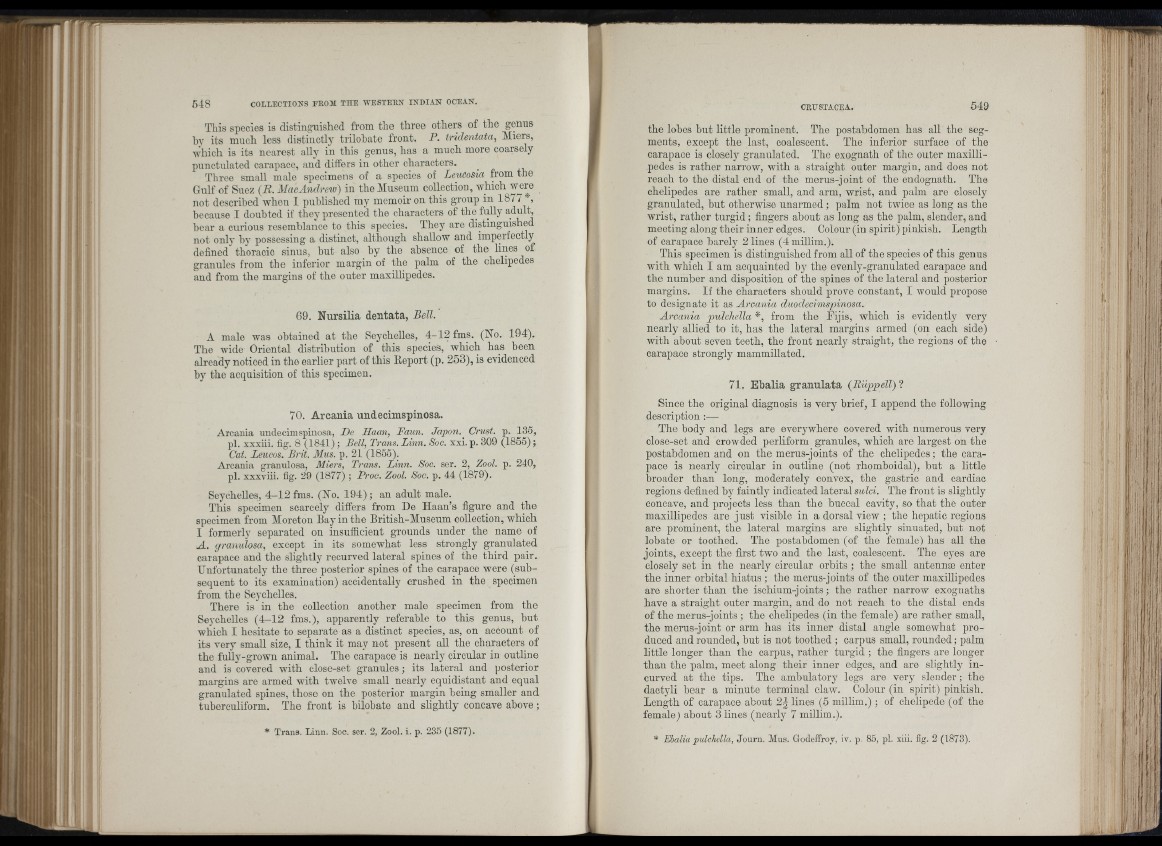
■Ì,
Si:'
This species is distinguished from tbe three others of the genus
bj’ its mucb less distinctly trilobate front. P. tridentata, Aliers,
A\dnch is its nearest ally in this genus, lias a mucb more coarsely
punctulated carapace, and differs in other characters.
Tkree small male specimens of a species of Leucosia from the
Gulf of Suez (B. AIacAnd.rew) in the Aluseum collection, which w/re
not described Avheu I published ray memoir on tbis group in 1877 *,
because I doubted if they presented tbe characters of the fully adult,
bear a curious resemblance to this species. They are distinguished
not only by possessing a distinct, although shallow and impm'fectly
defined thoracic sinus, but also by the absence of the lines of
granules from tbe inferior margin of the palm of tbe chelipedes
and from the margins of tbe outer maxillipedes.
69. Nursilia dentata, Bell.
A male was obtained at tbe Seychelles, 4 -12 fms. (No. 194).
Tbe wide Oriental distribution of this species,' wbicb has been
already noticed in tho earlier part of this Eeport (p. 253), is evidenced
by tbe acquisition of tbis specimen.
70. Arcania undecimspinosa.
Arcania undecimspinosa, De Haan, Faun. Japon. Crusty p. 135,
pi. xxxiii. fig. 8 (1841) ; Bell, Trans. Linn. Soc. xxi. p. 309 (1855) ;
Cat. Leucos. Brit. Mus. p. 21 (1856).
Arcania granulosa, Miers, Trans. Linn. Soc. ser. 2, Zool. p. 240,
pi. xxxviii. fig. 29 (1877) ; Proc. Zool. Soc. p. 44 (1879).
Seychelles, 4 -12 fms. (No. 194) ; an adult male.
Tbis specimen scarcely differs from De Haan’s figure and the
specimen from Aloreton Bay in the Britisb-ATuseum collection, which
I formerly separated on insufficient grounds under tbe name of
A . granulosa, except in its somewhat less strongly granulated
carapace and the slightly recurved lateral spines of the third pair.
Unfortunately tbe three posterior spines of the carapace were (subsequent
to its examination) accidentally crushed in tbe specimen
from tbe Seychelles.
There is in tbe collection another male specimen from tbe
Seychelles (4-12 fms.), apparently referable to this genus, but
wbicb I hesitate to separate as a distinct species, as, on account of
its very small size, I think it may not present all tbe characters of
tbe fully-grown animal. Tbe carapace is nearly circular in outline
and is covered witb close-set granules ; its lateral and posterior
margins are armed witb twelve small nearly equidistant and equal
granulated spines, those on the posterior margin being smaller and
tuberculiform. Tbe front is bilobate and slightly concave above;
tbe lobes but little prominent. Tbe postahdomen has all the segments,
except the last, coalescent. Tbe inferior surface of the
carapace is closely granulated. The exognath of the outer maxillipedes
is rather narrow, witb a straight outer margin, and does not
reach to the distal end of the merus-joint of the endognatb. The
chelipedes are ratber small, and arm, wrist, and palm are closely
granulated, but otherwise unarmed; palm not twice as long as tbe
wrist, rather turgid ; fingers about as long as tbe palm, slender, and
meeting along tbeir inner edges. Colour (in spirit) pinkish. Length
of carapace barely 2 lines (4 millim.).
This specimen is distinguisbed from all of tbe species of tbis genus
Avith which I am acquainted by tbe evenly-granulated carapace and
the number and disposition of the spines of the lateral and posterior
margins. If the characters should prove constant, I would propose
to designate it as Arcania duodecimspinosa.
Arcania pulclidla *, from tbo Eijis, which is evidently very
nearly allied to it, has the lateral margins armed (on each side)
with about seven teeth, tbe front nearly straight, tbe regions of the
carapace strongly mammillated.
71. Ebalia granulata (Büppell) ?
Since the original diagnosis is very brief, I append tbe following
description :—
The body and legs are everywhere covered with numerous very
close-set and crowded perliform granules, which are largest on tbe
postabdomen and on tbe merns-joints of tbe chelipedes; tbe carapace
is nearly circular in outline (not rhomboidal), but a little
broader than long, moderately convex, the gastric and cardiac
regions defined by faintly indicated lateral sulci. Tbe front is slightly
concave, and projects less than tbe buccal cavity, so th at the outer
maxillipedes are ju st visible in a dorsal view ; the hepatic regions
are prominent, the lateral margins are slightly sinuated, but not
lobate or toothed. Tbe postabdomen (of tbe female) has all tbe
joints, except tbe first two and tbe last, coalescent. Tbe eyes are
closely set in the nearly circular orbits ; the small antennæ enter
tbe inner orbital hiatus ; the merus-joints of tbe outer maxillipedes
are shorter than the iscbium-joints ; tbe ratber narrow exognatbs
have a straight outer margin, and do not reach to tbe distal ends
of tbe merus-joints ; tbe chelipedes (in tbe female) are ratber small,
tbe merus-joint or arm has its inner distal angle somewhat produced
and rounded, but is not toothed ; carpus small, rounded ; palm
little longer than the carpus, ratber turgid ; tbe fingers are longer
than tbe palm, meet along tbeir inner edges, and are slightly incurved
at tbe tips. Tbe ambulatory legs are very slender ; the
dactyli bear a minute terminal claw. Colour (in spirit) pinkish.
Length of carapace about 2 | lines (5 millim.) ; of chelipede (of tbe
female) about 3 lines (nearly 7 millim.).
'i I
Ì »
i ÍhÍ" Î
■L j
t
: ;i' iiii ? i ji,
rii I ii • Í.’ 3 II lit
i!
:'■ H " i . I f ri. .5s..Ï U
i'. ' il*
I | i ' r i
iid f
iri
■ V:' i 1 d
A '■ ■
a:
«i-V Í
I